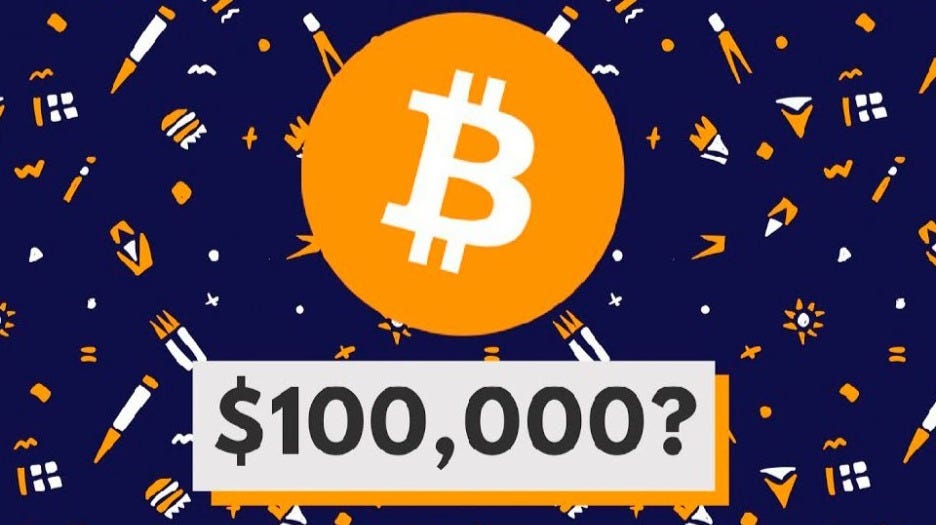Bitcoin’s ascent from 10k to more than 60k in value has established it as a formidable entity within the ever-evolving realm of cryptocurrencies. However, doubt remains whether Bitcoin can exceed the 100k milestone. This article examines the compelling reasons that will contribute to Bitcoin surpassing 100k. It investigates the future of finance in terms of technological advancements, economic dynamics, Bitcoin’s resilience as a unique asset class, and institutional recognition.
What is Bitcoin?
Bitcoin functions as a decentralised digital currency through its peer-to-peer network, eliminating the necessity for intermediaries like banks and enabling secure and transparent transactions. A 2009 creation was attributed to an unidentified individual or group by the alias Satoshi Nakamoto. Bitcoin’s foundational innovation resides in its blockchain technology, which functions as a publicly accessible ledger, securely and transparently documenting every transaction.
The generation of Bitcoins occurs via a procedure known as mining, wherein robust computing systems tackle intricate mathematical challenges to authenticate and append transactions to the blockchain. Furthermore, this procedure guarantees the integrity and security of the network.
The direct nature of Bitcoin transactions between users ensures confidentiality and independence. An investment vehicle, a medium of exchange, and a repository for value are all viable applications for the currency. Bitcoin is inherently deflationary due to its restricted supply of merely 21 million units, a defining characteristic.
Cryptographic security and its decentralised nature render Bitcoin impervious to censorship and fraudulent activities. It has garnered considerable interest as a prospective inflation hedge, a repository of value, and a revolutionary advancement in finance. Furthermore, the emergence of Bitcoin has catalysed the growth and progress of numerous additional cryptocurrencies and applications built upon the blockchain.
Unprecedented Growth in Adoption
Eleven years after its momentous transaction involving 3.8 billion pizzas, facilitated by Laszlo Hanyecz, Bitcoin continues to develop at an unprecedented rate. Chainalysis’s most recent data indicates a remarkable 881% increase in the adoption of cryptocurrencies, with India, Pakistan, and Vietnam accounting for more than 40% of the market. In contrast, the UK and the US trail behind by less than 10%.
The introduction of ProShares’ Bitcoin ETF signifies institutional acceptance, marking a pivotal moment. The adoption of Bitcoin as a legal tender in El Salvador and the participation of more than 80% of central banks in digital currencies demonstrate Bitcoin’s integration into global financial systems. Payment processors such as Venmo and platforms such as Robinhood, which simplify cryptocurrency investing, are entering the market, accelerating Bitcoin’s mainstream adoption and ensuring sustained demand.
Bitcoin as a Resilient Asset Class
Bitcoin has distinguished itself as a distinct asset class, providing a resilient defence against inflation, global uncertainties, and market volatility in defiance of previous criticisms. In contrast to gold, Bitcoin deftly navigates the complex intersection of speculation, wagering, and unconventional diversification. Bitcoin demonstrated a correlative strength of -0.03 with the S&P 500, commodities, real estate, energy, and emerging market currencies from 2012 to 2020. This characteristic renders Bitcoin an optimal instrument for implementing a diversified portfolio.
In the face of geopolitical uncertainties and the intensifying consequences of climate change, Bitcoin emerges as a resilient and forward-thinking asset due to its speculative allure and defensive capabilities. The asset’s ability to navigate economic fluctuations and exhibit a wide range of correlations with other assets enhances its appeal, thereby driving it closer to the $100,000 threshold.
Economic Dynamics: Supply and Demand
Mining operations have produced an estimated 18.4 million bitcoins out of 21 million. 10 to 30%of these are reportedly out of circulation due to forgotten credentials and hardware malfunctions. Anticipated halvings and the eventual termination of rewards per block at approximately 2140 will further diminish the supply.
A price increase is expected when an economic factor is considered: a declining supply and an expanding demand. In addition to systemic adoption and hedging considerations, dormant demand sources have substantial growth potential, specifically within the retail and consumer transactions sectors. The entry of significant companies such as Visa and MasterCard into the crypto-linked card market indicates that Bitcoin is gaining popularity beyond institutional funding.
Institutional Recognition and Adoption
Accumulating institutional acceptance and recognition for Bitcoin bolsters its ascent to 100k. The inaugural Bitcoin ETF from ProShares has served as a model for subsequent ETF offerings by Invesco, VanEck, Valkyrie Digital Assets, and Galaxy Digital. Significantly, the adoption of Bitcoin as a legal tender in nations such as El Salvador and the participation of over 80% of central banks in digital currencies indicates a worldwide transition towards acknowledging the legitimacy of Bitcoin.
Payment facilitators like Venmo and platforms like Robinhood facilitate consumer access to cryptocurrency investments. The relaxation of restrictions on cryptocurrency advertisements by major corporations like Google and Facebook further propels Bitcoin’s acceptance into the mainstream.
Technological Advancements and Innovation
Constant technological innovation and progress are integral to Bitcoin’s ascent to 10k. Blockchain technology, renowned for its security and transparency, continues to develop. In response to previous apprehensions regarding the efficiency of Bitcoin, the integration of Segregated Witness (SegWit) and the Lightning Network improves the cryptocurrency’s scalability and transaction speed.
Furthermore, the emergence of decentralised finance (DeFi) platforms constructed upon the Bitcoin blockchain presents novel opportunities for the provision of financial services. By allowing Bitcoin to participate in decentralised exchanges and intelligent contracts, innovations such as bundled Bitcoin (WBTC) expand its utility beyond a simple store of value.
Conclusion
As one traverses the intricate realm of cryptocurrencies, investors and enthusiasts remain enthralled by the upward trajectory of Bitcoin’s value. The examination of several influential elements—unprecedented expansion, asset class resilience, economic dynamics, institutional acknowledgement, and technological progress—consolidates to present an optimistic outlook on the future of Bitcoin. Although the trajectory may be unpredictable, the factors that will cause bitcoin to cross 100k serve as cornerstones, steering us towards a paradigm shift in digital finance.




